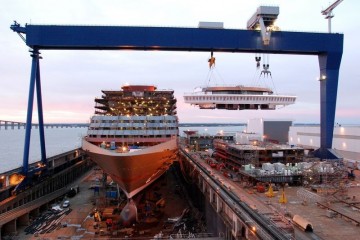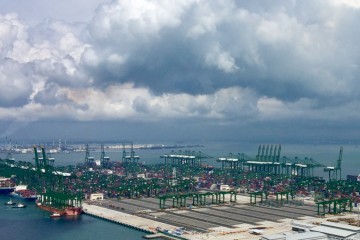Again one of those weeks when shipping holds its breath. Last week, the Marine Environment Protection Committee of the IMO took place, MEPC for insiders. This resulted in good and clear decisions on sulphur and NOx, but the outcome on greenhouse gas emissions got mixed reviews. Some called it a historical milestone, others an abject failure. Who is right? And what are the wider implications to this story?
It is all about management of expectations, as I mentioned earlier. Those who were under the impression that this meeting was for once and for all going to determine shipping’s emissions target, were certainly disappointed. Those who thought that the meeting was about discussing a plan could be happy, because this was actually achieved. And those who spoke of historical milestones must have had very low expectations – or a fairly odd sense of history. The aim for this MEPC was clear: decide on a roadmap, but the rhetoric prior to the meeting was more ambitious, so one could be forgiven for expecting more.
So, what exactly was decided? The MEPC agreed on a plan with a timeline that covers the period 2017-2023, in short: a roadmap. The plan foresees in the adoption of an initial IMO Strategy in the Spring of 2018, that includes a list of measures with possible timelines, “to be revised as appropriate as additional information becomes available”. Such information could come from the data collection system that starts in 2019. A revised IMO strategy would be adopted in Spring 2023 and include measures with implementation schedules.
Seriously?
What!? Is this serious? one could be tempted to say. Is it really necessary to wait seven years before adopting a strategy on reducing greenhouse gas emissions from ships? Because it could actually take seven years. There is no guarantee that the Initial Strategy in 2018 will be anything more than a list with options. After all, the strategy will be revised in 2023, and the roadmap explicitly states that the Initial Strategy “does not prejudge any specific further measures that may be implemented in phase 3 of the 3-step approach”. So – less cryptically: a decision on market-based measures – such as a carbon tax or an emissions trading scheme – cannot be taken before 2023. Moreover, the roadmap does not talk about a target for shipping emissions, not even in suave terms as shipping’s “contribution” or “fair share”. If a climate skeptic were to devise a cunning plan to buy time, it would probably look like this. Yet, there is another side to it.
Five elements in defense of the roadmap
First, the fact that there now is a roadmap was not evident from the outset. There was resistance from various emerging countries and more than 170 countries found a compromise. If the roadmap is an abject failure, the absence of a roadmap would obviously have been even more abject. The fact that it is only a roadmap is not the fault of last week’s meeting, but of the accumulation of all the previous meetings – e.g. the one six months ago.
Second, the shipping sector itself was one of the constructive forces in the process. Organisations like ICS and BIMCO feel the heat of regional measures they do not like (such as inclusion of shipping in the EU Emissions Trading Scheme), so are eager to show some progress. Blockage was coming from some emerging countries for reasons that are more or less justified. This is important: progress could be made by addressing these concerns one by one, and the shipping sector could actually help in this effort.
Third, a lot more time for discussion is scheduled in the coming years to prepare the Strategy. This takes the form of “intersessional meetings” of the IMO, so meetings that take place between the regular MEPC meetings. Such intersessional meetings are fairly exceptional, so having a series of these planned in advance is a signal of the dedication of IMO and its member states to the subject. Lack of time can no longer be an excuse.
Four, the roadmap is a fairly open document. Although it gives no guarantee for quick progress, it actually contains hooks for improvements, e.g. to add an emissions target. If prepared pro-actively, the 2018 Initial Strategy could be more solid than most of countries’ current Nationally Determined Contributions (NDCs).
Five, the 2018 and 2023 Strategies are explicitly linked to the stocktaking process of the UNFCCC, the organisation in charge of the yearly conferences of parties (COPs) that discuss on climate change. Being part of this stocktaking process means that maritime transport will be – more than in the past – part of the naming and shaming process that has nudged certain countries into climate change action.
So, as baffling as this may sound, the roadmap is – in a way – actually quite an accomplishment. This is not shipping’s equivalent to the Paris agreement; we will only see the sector’s contribution in 2018 at the earliest – if we are lucky. Yet, even according to neutral observers, this was actually a very good outcome considering the circumstances.
The assessment should not stop here. There is something very disturbing about the fact that a very good meeting – according to insiders – can lead to an outcome that seems obnoxiously unambitious to outsiders. The discussion should not be about whether insiders or outsiders are right. It should rather be about the systemic circumstances that hinder more ambitious outcomes – and how to resolve these.
What are the systemic constraints?
Just a few observations.
Most of the progress takes place during the IMO meetings. Most of the work done in-between meetings consists of explaining/defending the outcomes of the previous meeting and preparing proposals for the next meeting, that need to be submitted months before the meeting. So, there is actually not a lot of time to find compromises between opposing views. As far as I understand in the six months between each MEPC hardly any diplomatic interaction takes place between the countries that oppose each other in IMO meetings. Part of this is related to resources: various delegates go back to their capitals where a lot of other work is waiting for them. Part is related to organisation.
The progress that takes place at IMO meetings is constrained by mandates that delegates get from their governments. If a country delegate is mandated to block a shipping emissions target, because its Ministry of Finance or Trade is worried about the effects this could have on national trade revenues, there is hardly any way that an MEPC meeting could un-block this situation, whatever compromise is offered.
Although intersessional meetings address part of these constraints – by offering more time for finding solutions – they only go so far in resolving the issue. In the roadmap, the intersessional meetings are planned just prior to the regular MEPC meetings, so these would not actually allow for time for delegates to revise their original mandate in their capitals between an intersessional meeting and the MEPC meeting.
So, more structural changes would be needed to realise significant progress. Three suggestions:
1. Design this as a continuous process
Much more work could be done in-between MEPC meetings. Some of the emerging economies that block ambitious action within IMO have concerns that might or might not be justified. Leading “progressive” shipping nations should reach out to discuss, assess and resolve such concerns. The discussion on shipping’s reduction of greenhouse gas emissions should be a permanent and continuous effort.
This could take different forms. It could be brokered by academics or other “neutral” organisations. There could be a dedicated platform or organisation within the IMO to take care of it. And countries or regional blocks could take their responsibility. A way for the European Commission to ward off proposals by the European Parliament for regional measures, could be to intensify (or rather: start) climate diplomacy with counterparts in Argentina, Brazil and India on their concerns.
2. Make it a really comprehensive strategy
Part of the gap between efforts and outcomes can be explained by traditional fixation on the global level, on what is happening in IMO meeting rooms. However, a lot more is happening than international regulations or discussions: there are private initiatives, national, regional and local initiatives, many of which by different actors than ship-owners. A comprehensive strategy on reduction of GHG emissions from ships should take this into account. Hopefully the Initial Strategy could include measures that this blog has discussed earlier, such as speed limits and smart mechanisms modeled after the Norwegian NOx-fund, at whatever intervention level. A world with only global solutions might be ideal, but reaching this heavenly state might require a transition phase with a patchwork of local, national, regional and global measures inter-acting at the same time.
3. Be more transparent
The global maritime debate is fairly closed and secretive. Journalists are admitted but only allowed to report on outcomes, not on actual discussions. An indication of the level of transparency of decision-making is that the “historic” roadmap cannot be found online (yet). Some negotiations need secrecy so that nobody loses face in public. But sometimes, the fear of losing face in public can actually be a driver for change.
1 Comments
Comments are closed.




[…] roadmap is essentially a time-buying device. It buys time for countries that want to avoid anything stringent soon, for bureaucrats that want to be sure of the feasibility of measures before proposing a target […]